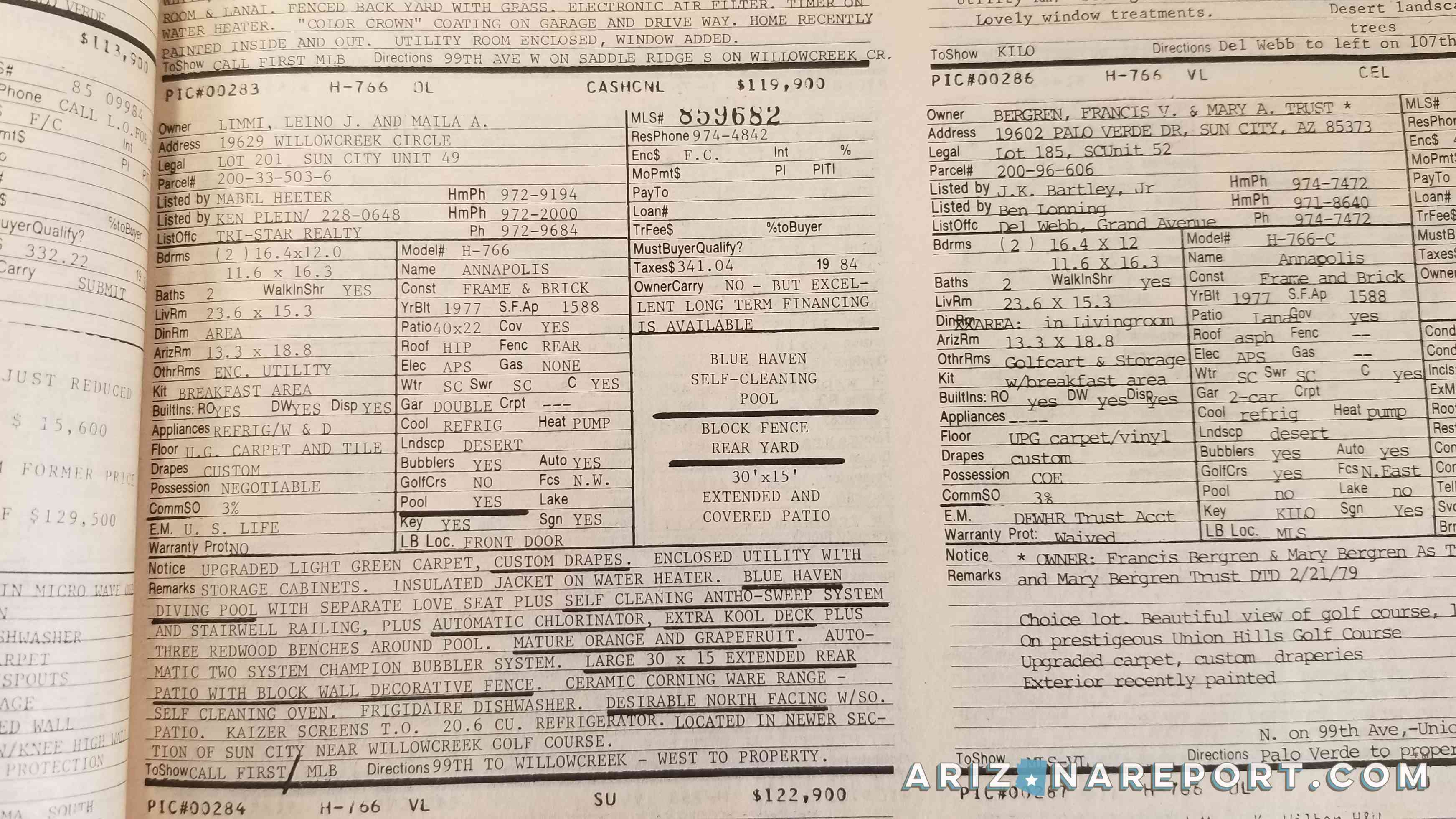- Fountain Hills Ties as Safest Zip Code in Phoenix - Oct 14, 2019
- How Many Single-Family Homes in Maricopa County? - Oct 13, 2019
- Investing in Multi-Family Real Estate in Your 20s - Oct 9, 2019
Let’s jump back in time to see what the MLS real estate database looked like 35 years ago.
The DeLorean is running and the flux capacitor is dialed to October 15, 1985. Our destination is a real estate office in Sun City, Arizona. Strap in. At precisely 88 miles per hour, we are vaporized and transported back to the pre-Internet age. Great Scott!
The MLS before the Internet
Before the web, the real estate industry was powered by catalogs. Paper catalogs called MLS books. Nothing electronic or digital about them. These hefty books resembled the White Pages or a black-and-white Sears catalog. All cooperating real estate firms in a marketplace contributed their property listings to the publication.

Before the internet, agents and homebuyers used MLS books. These were catalogs that were printed and distributed every few weeks that featured all of the Realtor listings in a city, town or county.
Watch the video below to see my example and explanation of an MLS book.
By aggregating data on homes for sale across multiple brokers, these books provided a win-win where there had previously been no organized information sharing between brokers. Choices for the consumer increased and brokers had a wider variety of listings to offer their clients. Sellers, too, had a wider crosstown audience of buyers for their homes.
What was inside?
Much of the same type of information that you find on real estate websites today was offered in the old MLS books. However, due to space constraints and publication limits, the information was truncated. I suspect that the abbreviations crammed into these books are the reason that we have a library of real estate acronyms in the online MLS today. The book’s appendix listed the acronyms and their translations.
With a magnifying glass, you could find the following information for each property listing:
- street address
- annual property tax amount
- room dimensions
- lot size
- asking price
- remarks/description
- directions
- seller’s phone number
- listing broker’s phone number
Toward the back of the book, you would see statistics on homes that had recently been sold. This allowed agents to have a resource from which to build CMAs. A CMA is a comparable market analysis. That’s an opinion of market value from an agent that is based on similar homes nearby that have closed escrow in recent months. Sellers relied on this information to get top dollar and a quick sale. Appraisers also depended on the sold data in the MLS books to complete their reports.
Need to find the desk phone number of an agent on the other side of town? There was a phone directory of local real estate offices and agents inside.
Watch this episode to see what MLS books look like:
The problem with MLS books
While all of the property listings in a marketplace could then be found in one publication, the MLS books did have disadvantages. The books were expensive to print, so most individual real estate agents did not own them. They relied on their brokers to maintain an office copy. This also meant that the books could not leave the firm.
I remember copying information by hand off of the pages and xeroxing pages to deliver to my clients. All Realtors in the office knew that the books never left the conference room. “For Member Use Only” was printed on the front cover to remind agents that they could not be loaned outside the firm.
Due to production costs and space limitations, there was one glaring omission from many early MLS books. Pictures. There were no photographs in the version of the 1985 Sun City MLS book that I found. However, I do remember a single, grainy black-and-white front elevation photo in later catalogs from the 1990s.
More information, please
The front of the books contained details on the new and current listings. The covers featured area maps. Each property was assigned an MLS number by the local real estate board. Squeezed onto the page in tiny print were the pertinent pieces of information that buyers and agents needed to schedule a showing.

This is a close-up view of a page from the October 15, 1985 Sun City MLS book. Each property was featured with details about price, room sizes, property taxes and contact information.
“Book Day” was every third Wednesday around my office. That’s when the printer would deliver the publication to our broker. It was almost a minor holiday for buyer clients and many real estate agents. Realtors in our conference room looked like medieval monks carefully transcribing text from a sacred book onto parchment. When it later became available, the online MLS was the technological equivalent of the Gutenberg Press to the old manuscripts.
To the future!
Technology has drastically improved how Realtors and buyers find information on homes for sale. Today, buyers can search 1000s of properties in their local market with a click of a mouse. They never need to leave home.
There is now almost real-time information for all market participants using an electronic MLS. Although there are still minor inaccuracies from time to time with MLS data, we are light years ahead of the old books. Color photos, virtual tours, aerial views and parcel maps online empower the consumer with richer information. I can’t imagine shopping for a home across the country without the internet.
The online MLS is a quantum leap forward from the printed version.
What happened to MLS books?
When I joined the industry in 1997, we used the old catalog system. The online version of the MLS was just rolling out in my market. The Realtor boards offered classes on how to use and query the new online dial-up database. Agents switched en masse to the new technology with the exception of a few veterans who wouldn’t give up their old methods.
Over time, it was no longer financially feasible for the local real estate boards to continue publishing the MLS books. I recall the MLS books being fully phased out by 2003.
Many offices, like mine, kept both the old and new MLS formats for many years during the transition. It was a parallel system. The books were always a fall-back in the event that the new-fangled electronic MLS crashed. It never did. The web-based MLS format continued to improve and win over agents and buyers alike. We didn’t look back.
A humorous look back
I stumbled across the Sun City MLS book in the video above on eBay about a year ago. I just had to have it. Six dollars. It’s a relic that reminds me of my first year as a licensed agent. Who else would have a use for it? I enjoy sharing it with new and old agents alike to chuckles and gasps of astonishment.
This episode was recorded in my Scottsdale studio on April 9, 2019.
I won an amateur night, October 8th, 1985. I went to work the next day and quit my job.
– Steve Harvey, American comedian, TV host and producer







